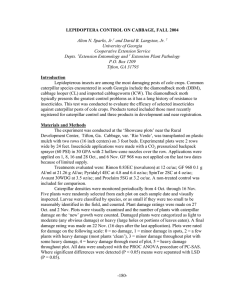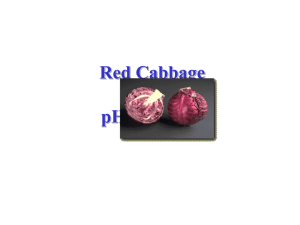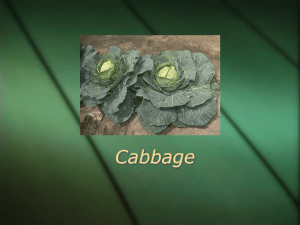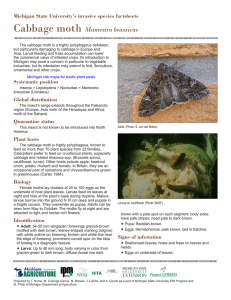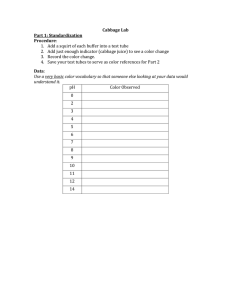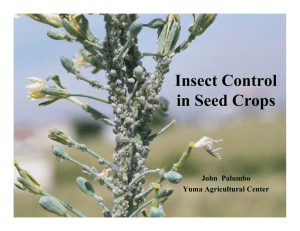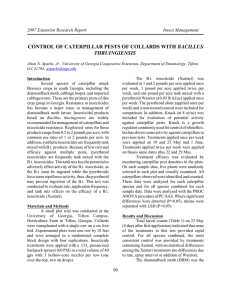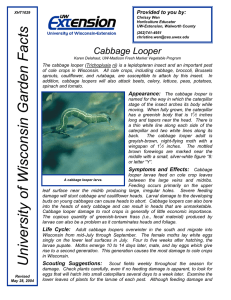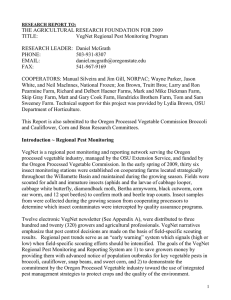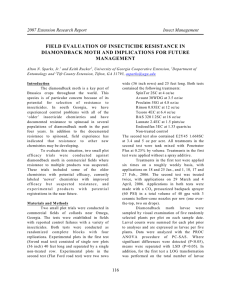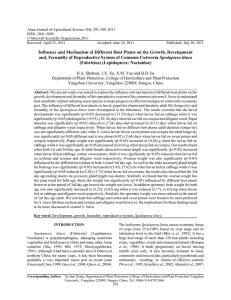EVALUATION OF FMC INSECTICIDE TREATMENTS IN CABBAGE 2007
advertisement
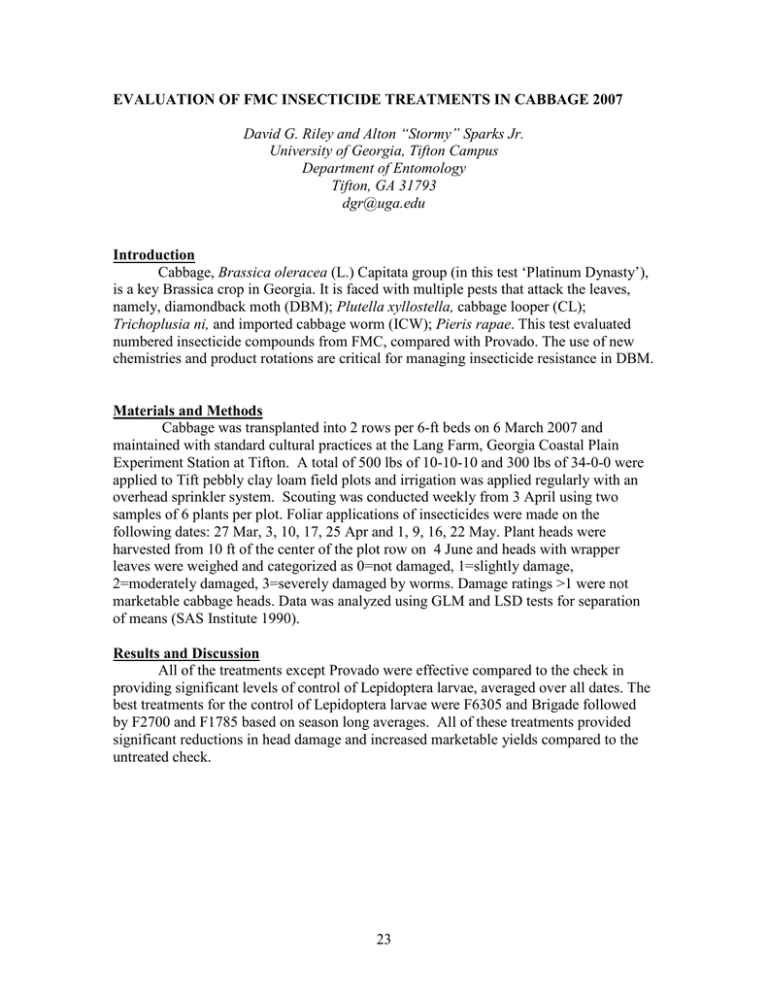
EVALUATION OF FMC INSECTICIDE TREATMENTS IN CABBAGE 2007 David G. Riley and Alton “Stormy” Sparks Jr. University of Georgia, Tifton Campus Department of Entomology Tifton, GA 31793 dgr@uga.edu Introduction Cabbage, Brassica oleracea (L.) Capitata group (in this test ‘Platinum Dynasty’), is a key Brassica crop in Georgia. It is faced with multiple pests that attack the leaves, namely, diamondback moth (DBM); Plutella xyllostella, cabbage looper (CL); Trichoplusia ni, and imported cabbage worm (ICW); Pieris rapae. This test evaluated numbered insecticide compounds from FMC, compared with Provado. The use of new chemistries and product rotations are critical for managing insecticide resistance in DBM. Materials and Methods Cabbage was transplanted into 2 rows per 6-ft beds on 6 March 2007 and maintained with standard cultural practices at the Lang Farm, Georgia Coastal Plain Experiment Station at Tifton. A total of 500 lbs of 10-10-10 and 300 lbs of 34-0-0 were applied to Tift pebbly clay loam field plots and irrigation was applied regularly with an overhead sprinkler system. Scouting was conducted weekly from 3 April using two samples of 6 plants per plot. Foliar applications of insecticides were made on the following dates: 27 Mar, 3, 10, 17, 25 Apr and 1, 9, 16, 22 May. Plant heads were harvested from 10 ft of the center of the plot row on 4 June and heads with wrapper leaves were weighed and categorized as 0=not damaged, 1=slightly damage, 2=moderately damaged, 3=severely damaged by worms. Damage ratings >1 were not marketable cabbage heads. Data was analyzed using GLM and LSD tests for separation of means (SAS Institute 1990). Results and Discussion All of the treatments except Provado were effective compared to the check in providing significant levels of control of Lepidoptera larvae, averaged over all dates. The best treatments for the control of Lepidoptera larvae were F6305 and Brigade followed by F2700 and F1785 based on season long averages. All of these treatments provided significant reductions in head damage and increased marketable yields compared to the untreated check. 23 Total Lepidoptera larvae 5/8/07 Diamondback moth larvae 5/15/07 Cabbage looper larvae 5/15/07 Total Lepidopter a larvae 5/15/07 Imported cabbage worms 5/22/07 Total Lepidoptera larvae 5/22/07 1. F6305 30 WG 0.11 lb ai/a Diamondback moth larvae 5/8/07 2.3 b 2.8 d 3.3 b 0.0 b 4.3 b 0.3 b 5.3 c 2. F1785 10 WP 0.088 lb ai/a 4.0 b 6.0 bc 3.3 b 1.0 ab 5.0 b 5.5 ab 15.0 abc 3. Brigade WSB 10WP 0.1 lb ai/a 3.0 b 3.0 d 3.5 b 0.3 b 4.0 b 0.3 b 7.8 c 4. F2700-04-1 0.83EC 0.025 lb ai/a 2.8 b 3.8 cd 4.0 b 0.0 b 5.3 b 0.3 b 1.0 bc 5. Provado 1.6 3.8 oz product/a 3.5 b 7.3 b 4.8 b 0.8 b 5.8 b 6.5 a 21.5 a 6. Untreated check 6.8 a 12.0 a 10.5 a 2.0 a 15.0 a 10.3 a 19.8 ab Treatment - rate per acre • Means within columns followed by the same letter are not significantly different (LSD, P<0.05). Overall Diamondback moth 1.69 b Imported cabbage worm 0.19 b Leps total Overall 1. F6305 30 WG 0.11 lb ai/a Overall Cabbage looper 0.06 b 1.94 c Wrapper Damage rating 1.23 de Head Damage rating 0.28 c Marketable Weight of Cabbage 48 a 2. F1785 10 WP 0.088 lb ai/a 0.67 a 1.97 b 0.86 b 3.50 bc 2.13 bc 0.95 b 34 ab 3. Brigade WSB 10WP 0.1 lb ai/a 0.08 b 1.89 b 0.08 b 2.06 c 1.00 e 0.23 c 45 a 4. F2700-04-1 0.83EC 0.025 lb ai/a 0.14 b 2.28 ab 0.31 b 2.72 bc 1.68 cd 0.73 bc 43 ab 5. Provado 1.6 3.8 oz product/a 0.78 a 2.97 ab 1.00 ab 4.75 ab 2.63 ab 1.75 a 24 bc 6. Untreated check 0.92 a 3.50 a 1.86 a 6.28 a 2.73 a 2.03 a 11c Treatment - rate per acre * Seasonal means within columns followed by the same letter are not significantly different (LSD, P<0.05). 24
